
Opinions expressed here are ours alone, and are not provided, endorsed, or approved by any issuer. Our articles follow strict editorial guidelines and are updated regularly.
When you use your credit card to pay for purchases online or in a store, or to transfer and receive money, a sort of technical magic takes place. A lot is happening on the backend to make sure those transactions are seamless, accurate, and fast.
You will not generally notice the processing fees because they are often embedded in the cost of doing business. Sometimes, however, the merchant directly passes those costs onto the consumer.
Here are 25 credit card processing statistics that may surprise you and suggestions on how to keep fees of all kinds to a minimum.
1. The Global Credit Card Payment Market is Valued at $151.8B
Every time someone uses their credit card account, money is being spent and made. That’s why the credit card payment industry is unquestionably huge.
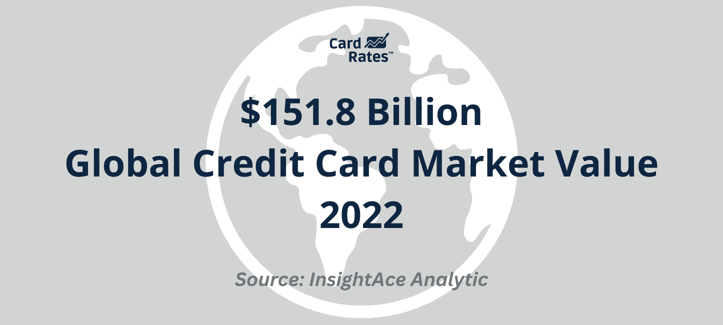
In fact, as consumers across the globe traded cash for plastic, credit card transactions became an extraordinarily lucrative business. In 2022, the global credit card payments market size was valued at $151.8 billion.1
2. Predicted 2031 Credit Card Payment Market Size: $327.68B
The business of credit card transactions is expected to rise over the years, with a projected worth of $327.68 billion in 2031.1
Why?
- An increasing number of companies, from eCommerce to brick-and-mortar retailers, depend on electronic banking.
- The market for credit card payments is expanding as those companies offer rewards and perks to a growing number of customers.
3. The Credit Card Processing Annual Growth Rate is 5.1%
A lot goes into making sure that, when you spend with your credit card or transfer the funds to somebody else, the other party gets the money safely.
It’s called credit card processing, and the market size of the credit card processing and money transfer industry in the US has grown 5.1% annually. This is the average figure for the years between 2017 and 2022, and it shows no sign of slowing down.2
4. The Credit Card Payments Market is Dominated by 9 Companies
Plenty of financial institutions provide credit cards to consumers, but there are only a few key players in the space1:
- American Express
- Bank of America Corporation
- Barclays PLC
- Capital One
- Citigroup Inc.
- JP Morgan Chase & Co,
- MasterCard
- Synchrony
- PNC Financial Services
5. 166M Consumers Have a Credit Card Account
As of 2022, some 166 million US consumers have a credit card, a figure that is up from 159.5 million consumers in the previous year.3
Credit card options exist for people with a great span of credit ratings, so it’s no wonder so many people have these payment tools at the ready. You can get a card if you’re just starting out and have no credit history and if you have a damaged credit rating because you have had some past problems with payments and debt.
6. 31% of Payments Were Made With a Credit Card in 2022
In 2022, just over one-third of all payment transactions were made with a credit card.4 By comparison:
- 29% of the transactions were made with a debit card
- 18% were made with cash
- 13% were made via ACH
- 9% with “other”
- 1% with a mobile app
7. Nine out of 10 Merchants Accept Credit Cards
Consumers report that credit and debit cards are accepted as payment methods 90% of the time.4
That’s good news for people who want to use plastic, whether a physical card, just the account information, or a mobile wallet. Using your credit card wherever you go is a universal convenience.
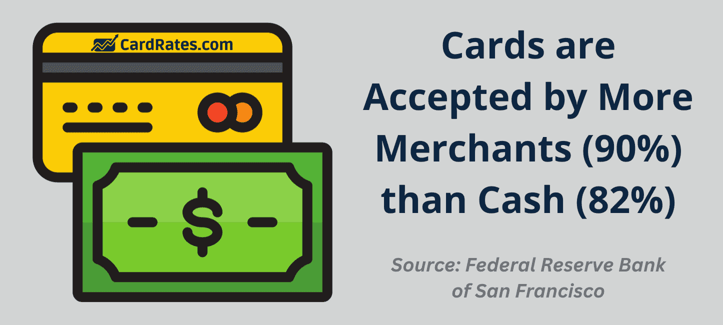
As for cash, 82% of consumers say cash was accepted everywhere, a number that is still high, but not as ubiquitous as cards.
8. Visa Payment Cards Were Used to Make 242 Billion Global Purchase Transactions in 2022
Do you have a card with a Visa emblem imprinted on it? You’re not alone The payment processing company accounted for approximately four of 10 global card transactions in 2022.5
Although Visa is a US company based in San Francisco, it facilitates electronic funds transfers domestically and internationally, usually with its branded credit, debit, and prepaid cards.
9. Total Global Credit Card Transactions: 678 Billion
So just how common are credit card transactions? In 2022, there were an estimated 678 billion global credit card transactions.6
Clearly it’s not just US consumers who turn to their credit cards to make their purchases or pay for services, but people all over the world.
10. There are 210 Credit Card Transactions Per Year, Per Person
The average US cardholder makes about 210 transactions with their credit card on an annual basis.6
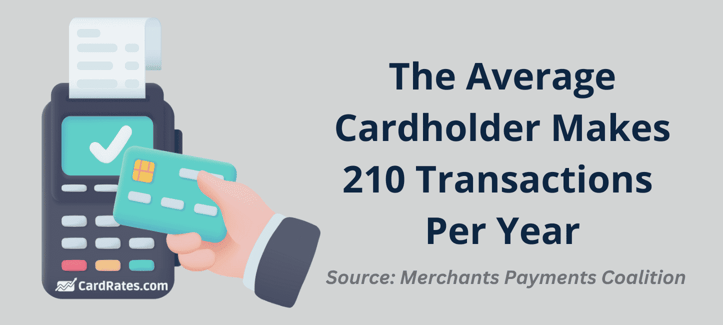
That may not sound like much, but when looking at the daily figure, it would be one credit card transaction every 1 3/4 days.
11. The Average Credit Card Purchase is $91
In the US, the amount of the average credit card purchase was approximately $91 per transaction in 2021.5
Therefore, as a consumer, you may be using cash or debit cards (where the money comes directly from the funds in your checking account) for smaller transactions, but credit cards come in handy when you want to make larger transactions.
12. Canada Has The Highest Global Credit Card Adoption Rate
In Canada, 83% of adults hold a credit card. At least 70% of adults in Israel and Norway also hold credit cards.
So where does the United States stand? Close: 68% of adults hold credit cards.7
13. About 14% of Americans Have 10 or More Credit Cards
The more credit cards you have, the more transactions you may make. Some Americans have a particularly high number of accounts at their disposal, with 14% owning at least 10 credit cards.8
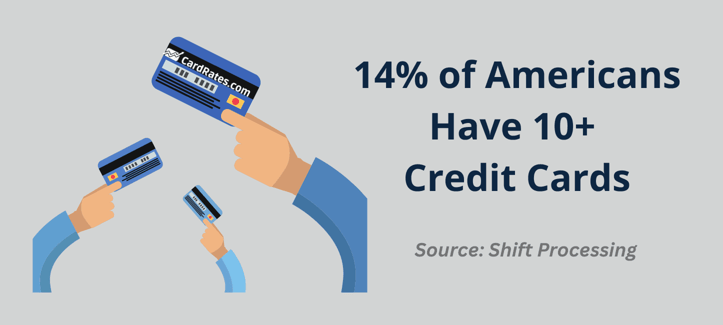
With that many cards on hand, a consumer can make a tremendous number of transactions, and the credit card companies can reap greater profits.
14. Visa Processes the Most Transactions
With so many merchants accepting credit cards all over the world, chances are you’ll be able to pay with your card. But not all merchants accept every payment network.
On a global scale7:
- 44 million merchants accept Visa
- 37 million accept MasterCard
- 31 million accept AMEX
- 30 million accept Discover
15. The Average Credit Card Processing Fee in the US is 2.24%
Each time you use your credit card to make a purchase, the merchant must pay a fee to process that transaction (also called a swipe fee). The average swipe fee in the US is 2.24% of the transaction.9
Although you don’t pay these fees directly, these charges do affect the merchants’ bottom line. Some may even pass those charges on to you as a surcharge.
16. Merchants Paid $160.7 Billion in Swipe Fees in 2022
The US banks and card networks charged merchants $160.7 billion in swipe fees in 2022 to process credit and debit card transactions. That’s a 16.7% increase from the previous year and is now an all-time record.
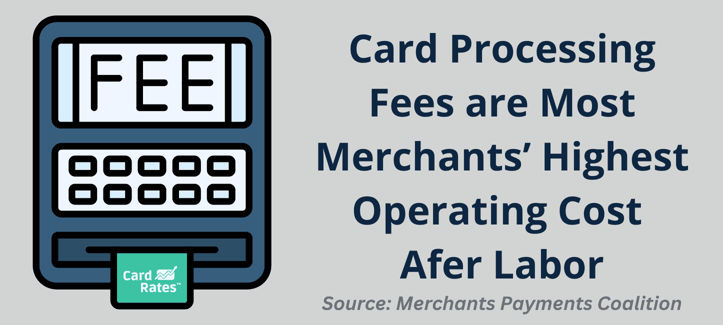
After labor, these fees are most merchants’ highest operating cost.10
17. Swipe Fees are Capped at 0.3% in Europe
The European Union capped swipe fees for all credit card transactions at 0.3% of the value of the transaction.11
That’s a huge difference from the average swipe fee payment processors can charge in the US, which can be up to 4%.
18. Visa and Mastercard Must Pay Retailers $5.6 Billion for a Lawsuit About Fees
More than 12 million retailers accused Visa Inc. and MasterCard Inc. of improperly fixing credit and debit card fees.
Eighteen years after a case was filed against the credit card transaction and payment processing companies, a class action settlement was agreed upon. In 2023, a $5.6 billion settlement was affirmed in a MasterCard/Visa interchange fee lawsuit.12
19. Paying with a Credit Card Costs 69% of Cardholders Extra
Do some merchants pass on the cost of the processing fees to the buyer? It appears that way.
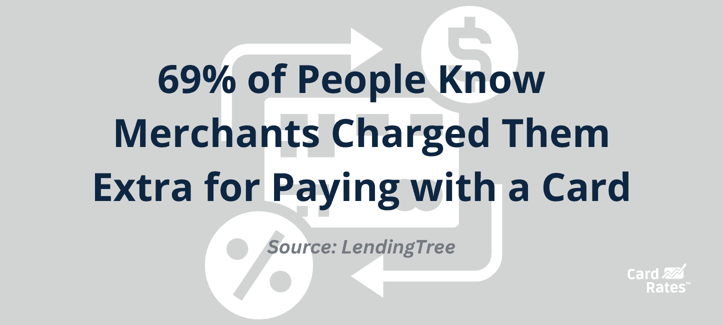
More than two-thirds of consumers (69%) say they know a merchant charged them extra for paying with a credit card.13
20. One-third of Credit Card Users Say They Weren’t Warned of the Additional Charge
Just over one-third of credit card users in the United States claim they were charged to use their credit card, but the merchant didn’t tell them beforehand.
Such lack of transparency is a huge problem for cardholders, 92% of whom say businesses should tell them about the surcharges prior to the payment process.13
21. More Than Half (57%) of Cardholders Believe Charging Consumers Processing Fees Should be Illegal
When the credit card processing fee lands in customers’ laps, they tend to bristle.
In fact, the majority of cardholders believe merchants should not have the legal right to pass these charges on to customers.13
22. About 39% Of Cardholders Don’t Know Card Companies Make Money on Interchange or Swipe Fees
Although the majority of cardholders know that credit card companies earn revenue from fees, such as applied interest, 39% of cardholders said they did not know credit card companies profit from interchange or swipe fees.
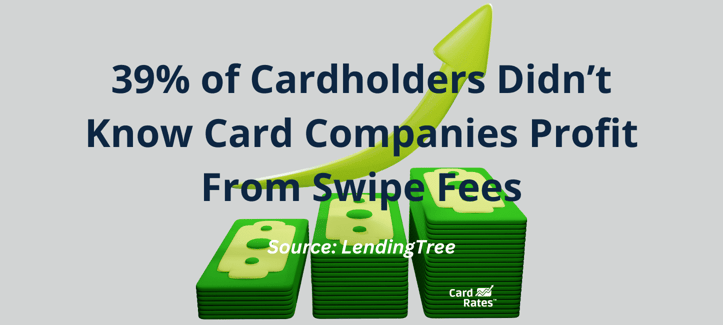
Furthermore, about half of consumers surveyed (52%) said they know those transaction costs add to the company’s bottom line.13
23. Nearly 3 Out Of 4 Cardholders Would Change Their Charging Habits if They Had to Pay a Surcharge
A large majority of consumers (73%) said they would curtail their transactions if they had to pay a surcharge to merchants each time they used their card. If given the choice, about half said they would prefer that the businesses include processing fees in the price rather than as a surcharge.13
24. 81% of Consumers Want the Government to Step in to Lower Credit Card Fees For Small Businesses
When asked about the government stepping in to ensure greater competition that will reduce credit card fees for small businesses, consumers were strongly in favor: 81% support federal legislation to lower fees.14
25. Credit Card Users in California Paid the Most in Swipe Fees, Mississippi the Least
Total paid swipe fees vary dramatically from state to state. The 10 states that paid the most are15:
| State | Total Swipe Fees |
|---|---|
| California | $97,474,291.77 |
| Massachusetts | 19,058,468.49 |
| New York | $46,220,401.28 |
| Hawaii | $4,778,915.38 |
| Maryland | $13,495,908.71 |
| Washington | $16,104,301.90 |
| Oregon | $8,894,631.86 |
| Alaska | $1,681,632.73 |
| New Jersey | $19,352,564.08 |
| New Hampshire | $2,898,472.70 |
The 10 states that paid the least in swipe fees are:
| State | Total Swipe Fees |
|---|---|
| Tennessee | $11,389,969.78 |
| Arkansas | $4,986,355.5 |
| West Virginia | $2,987,274.62 |
| Nebraska | $3,229,615.10 |
| Iowa | $5,237,899.20 |
| Alabama | $8,151,599.74 |
| Missouri | $9,972,200.37 |
| Kansas | $4,723,240.87 |
| Oklahoma | $6,236,665.14 |
| Mississippi | $4,648,703.15 |
The Final Say on Credit Card Fees
Credit card companies are businesses, not charities. To provide you with a line of credit that you can draw from, they have to turn a profit. Are the fees too high? Maybe. But if you want to charge purchases, be aware that processing fees will be imposed. Some fees you will see, others you won’t.
You can keep the cost of using credit cards down through several steps. While you don’t have any control over the processing fees between credit card companies and merchants, you can reduce the fees you as a cardholder may be charged. Here’s how:
- Choose a credit card that has either no annual fee or one where the value of the benefits exceeds the fee.
- Pay your bill by the due date so you are not charged a late fee. The easiest way is to enroll in automatic bill pay through your bank.
- Only charge what you will pay in full so interest fees are not added to the balance.
- Make sure you use a credit card that does not charge foreign transaction fees when you travel to international destinations.
- If you use a balance transfer credit card, delete the debt before the regular rate goes into effect. This way, you will save more than the transfer fee costs.
- Avoid going over your spending limit so you are not charged extra fees for exceeding your credit line.
- Avoid taking credit card cash advances. If you withdraw money from your credit card’s credit line, you will be charged a cash advance fee and immediately begin paying interest — often at a higher APR than what is calculated on purchases.
And remember, when you have credit cards that also let you earn cash back, points, or miles, you can make money just by charging and keeping the balance at zero. Some cards also have very valuable perks.
Such rewards programs and perks are expensive for the credit card company, though. How does the credit card company pay for them? The fees, of course!
Data Sources:
1 https://www.insightaceanalytic.com/report/credit-card-payments-market/1600
2 https://www.ibisworld.com/industry-statistics/market-size/credit-card-processing-money-transferring-united-states/
3 https://newsroom.transunion.com/q4-2022-ciir/
4 https://www.frbsf.org/cash/publications/fed-notes/2023/may/2023-findings-from-the-diary-of-consumer-payment-choice/
5 https://www.statista.com/statistics/261327/number-of-per-card-credit-card-transactions-worldwide-by-brand-as-of-2011/
6 https://capitaloneshopping.com/research/number-of-credit-card-transactions/
7 https://www.clearlypayments.com/blog/growth-of-credit-card-industry-in-2023/
8 https://shiftprocessing.com/credit-card/
9 https://nrf.com/blog/10-things-know-about-swipe-fees
10 https://merchantspaymentscoalition.com/merchants-say-record-jpmorgan-revenues-show-need-to-address-swipe-fees/
11 https://www.consilium.europa.eu/en/press/press-releases/2015/04/20/capping-fees-card-based-payments/
12 https://www.reuters.com/legal/visa-mastercard-56-bln-settlement-with-retailers-is-upheld-2023-03-15/
13 https://www.lendingtree.com/credit-cards/study/processing-fees/
14 https://nrf.com/media-center/press-releases/exclusive-nrf-survey-shows-less-one-quarter-consumers-trust-credit-card
15 https://www.forbes.com/advisor/business/swipe-fees-report/

![[current_year] Credit Card Debt Statistics (Average U.S. Debt) [current_year] Credit Card Debt Statistics (Average U.S. Debt)](https://www.cardrates.com/images/uploads/2018/04/shutterstock_243114739-edit.jpg?width=158&height=120&fit=crop)
![15 Disturbing Credit Card Fraud Statistics ([current_year]) 15 Disturbing Credit Card Fraud Statistics ([current_year])](https://www.cardrates.com/images/uploads/2020/08/shutterstock_576998230.jpg?width=158&height=120&fit=crop)
![21 Startling Credit Card Data Breach Statistics ([current_year]) 21 Startling Credit Card Data Breach Statistics ([current_year])](https://www.cardrates.com/images/uploads/2023/10/Credit-Card-Data-Breach-Statistics.jpg?width=158&height=120&fit=crop)
![11 Surprising Teen Credit Card Statistics ([current_year]) 11 Surprising Teen Credit Card Statistics ([current_year])](https://www.cardrates.com/images/uploads/2023/10/Teen-Credit-Card-Statistics.jpg?width=158&height=120&fit=crop)
![18 Revealing Credit Card Ownership Statistics ([current_year]) 18 Revealing Credit Card Ownership Statistics ([current_year])](https://www.cardrates.com/images/uploads/2023/11/Revealing-Credit-Card-Ownership-Statistics.jpg?width=158&height=120&fit=crop)
![21 Eye-Opening Student Debt Statistics ([current_year]) 21 Eye-Opening Student Debt Statistics ([current_year])](https://www.cardrates.com/images/uploads/2020/11/shutterstock_674141887.jpg?width=158&height=120&fit=crop)
